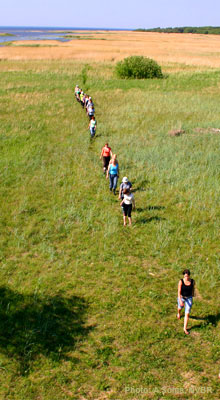 |
Ambassador profile
|
||
| Name: | Andris Soms | |
| Function: | Communication officer | |
| Country: | Latvia | |
| E-mail: | andris.soms(at)biosfera.gov(dot)lv | |
| Tel: | +37 16407 1408 | |
Organisation profile
|
||
| Organisation: | North Vidzeme Biosphere Reserve (NVBR) | |
| www: | www.biosfera.gov.lv | |
| E-mail: | biosfera(at)biosfera.gov(dot)lv | |
| Tel: | +37 16407 1408 | |
| Established: | 1997 | |
| Category: | Governmental Organization | |
| Number of staff: | 11 employees | |
 |
| Site profile | |||
| Site name: | Randu Meadows | ||
| Location: | Randu Meadows are located in Latvia, Limbažu district, territories of Ainažu and Salacgriva municipalities. | ||
| Land area: | 285 ha | ||
| Nearest urban settlement: | Ainaži and Salacgriva | ||
| Natura 2000 ID: | LV0509100 | ||
| www: | |||
| Annual visitor count: | Approximately 3,000 | ||
| Majority of visitors from: | Latvia | ||
| Site description: |
Coastal lagoons, fixed coastal dunes with herbaceous vegetation (grey dunes), Boreal Baltic coastal meadows, Wooded dunes of the Boreal region.
|
|
|
| Priority species | |||
| Species code | Latin name | Common / local name | |
| Agrimonia pilosa | |||
| Angelica palustris | |||
| Botaurus stellaris | Bittern | ||
| Circus aeruginosus | Marsh Harrier | ||
| Circus cyaneus | Hen Harrier | ||
| Crex crex | Corn Crake | ||
| Grus grus | Common Crane | ||
| Calidris alpina schinzii | Baltic dunlin | ||
| Philomachus pugnax | Ruff | ||
| Sterna hirundo | Common Tern | ||
| Sterna paradisaea | Arctic Tern | ||
| Sterna albifrons | Little Tern | ||
| Lullula arborea | Wood Lark | ||
| Anthus campestris | Tawny Pipit | ||
| Lanius collurio | Red-backed shrike | ||
| Leucorrhinia pectoralis | Large White-faced Darter Dragonfly | ||
| Lutra lutra | Otter | ||
| Mustela lutreola | European mink | ||
| Martes martes | Pine marten | ||
| Bufo calamita | Running toad | ||
| Pelobates fuscus | Common spadefoot, garlic toad | ||
| Rana temporaria | Common frog | ||
| Priority habitats (* indicates priority habitats) | ||
| Habitat code | Common / local name | |
| 1150* | Coastal lagoons | |
| 2130* | Fixed coastal dunes with herbaceous vegetation (grey dunes) | |
| 6230* | Species-rich Nardus grasslands, on siliceous substrates in mountain areas (and submountain areas, in Central Europe) | |
| 6270* | Fennoscandian lowland species-rich dry to mesic grasslands | |
| 1630* | Boreal Baltic coastal meadows | |
| 9080* | Fennoscandian decidous swamp forests | |
| Stakeholder profile | |||||
| Stakeholder activity in the management planning process: | |||||
| Stakeholder group | activity level | ||||
| hi ← → nil | |||||
| Local Government | |||||
| Scientists | |||||
| Private landowners | |||||
| Green NGOs | |||||
| Farmers | |||||
| Hunters | |||||
| Recreational groups | |||||
| Stakeholder success stories | |
|
Improving tourism infrastructure - nature trail and bird watching tower In 2006, NVBR, in
close cooperation with land owners and the local municipality NVBR administration,
invested funds in the construction of a novel bird watching tower and
nature trail. Land owners and the municipality allocated their lands
for public access, free of charge. |
|
|
Reintroduction of cattle in the meadows
|
|
|
Management plan |
|
| Photo credit: Andris Soms |
| Communication profile | |
|
Activities and products for the communication of Natura 2000
|
|
| Events | |
|
|
| Event frequency | |
|
|
| Use of seasonal workers / volunteers | |
|
|
| Communication literature produced | |
|
|
| Communication target groups | |
|
|
| The organisation has a dedicated communication strategy for Natura 2000 | |
|
|
| Site involved in joint working / networking | |
|
|
|
|
|
| Key site management issues: | |
|
|
|
| Integration of Natura 2000 in overall site management: | |
|
The Natura 2000 site is within the boundaries of the North Vidzeme Biosphere Reserve (NVBR). Therefore all the management activities carried out in the NVBR are directly or indirectly connected with the Natura 2000 site.
|
|
| Key site management objectives: | |
|
|
|
| Stakeholders targeted as part of management action: | |
|
|
|
| Description of work carried out / methods and methodology: | |
|
|
|
| Results of action and activities: | |
|
The farmers can
raise the cattle and if necessary the municipalities rent their land
to owners. The first results of meadow and lagoon restoration are evident
already. Farmers use new agricultural programs - Agro-Environment for
getting support for grazing activities. |
|
| Financial overview | |
| European funding: | |
|
|
 |
 |